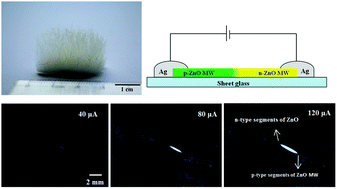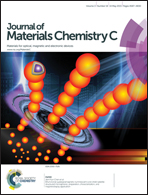ZnO single microwire homojunction light emitting diode grown by electric field assisted chemical vapor deposition
Abstract
ZnO microwire (MW) homojunction light emitting diode (LED) arrays were grown on a Si substrate by an electric field assisted chemical vapor deposition method. The sequential growth of the Sb-doped p-type ZnO MW along the undoped n-type ZnO MW is controlled by the application of the external longitudinal electric voltage. Low-temperature microscopic photoluminescence spectra from the Sb-doped ZnO MW segment exhibit strong emissions of neutral-acceptor-bound exciton (A0X) emission, free electron to the acceptor (FA) and donor–acceptor pair (DAP). The acceptor binding energy is estimated to be ∼125 meV at 10 K. The I–V characteristic of a single ZnO microwire LED showed a good rectifying behaviour with a turn-on voltage of about 3.5 V. Blue white electroluminescence (EL) is visually observed at room temperature, the intensity of which increased with increasing the injected current. The electric field assisted CVD method to grow ZnO MW homojunction LED arrays opens up a new possibility for fabricating the ZnO based p–n junction devices.


 Please wait while we load your content...
Please wait while we load your content...